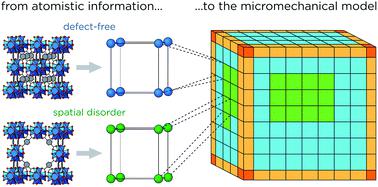当前位置:
X-MOL 学术
›
Faraday Discuss.
›
论文详情
Our official English website, www.x-mol.net, welcomes your feedback! (Note: you will need to create a separate account there.)
The micromechanical model to computationally investigate cooperative and correlated phenomena in metal–organic frameworks
Faraday Discussions ( IF 3.4 ) Pub Date : 2020-01-15 , DOI: 10.1039/c9fd00148d Sven M. J. Rogge 1, 2, 3, 4
Faraday Discussions ( IF 3.4 ) Pub Date : 2020-01-15 , DOI: 10.1039/c9fd00148d Sven M. J. Rogge 1, 2, 3, 4
Affiliation

|
Computational insight into the impact of cooperative phenomena and correlated spatial disorder on the macroscopic behaviour of metal–organic frameworks (MOFs) is essential in order to consciously engineer these phenomena for targeted applications. However, the spatial extent of these effects, ranging over hundreds of nanometres, limits the applicability of current state-of-the-art computational tools in this field. To obtain a fundamental understanding of these long-range effects, the micromechanical model is introduced here. This model overcomes the challenges associated with conventional coarse-graining techniques by exploiting the natural partitioning of a MOF material into unit cells. By adopting the elastic deformation energy as the central quantity, the micromechanical model hierarchically builds on experimentally accessible input parameters that are obtained from atomistic quantum mechanical or force field simulations. As a result, the here derived micromechanical equations of motion can be adopted to shed light on the effect of long-range cooperative phenomena and correlated spatial disorder on the performance of mesoscale MOF materials.
中文翻译:

用于计算研究金属-有机框架中的合作和相关现象的微力学模型
为了有意识地设计这些现象以用于目标应用,对协作现象和相关的空间无序对金属有机框架(MOF)宏观行为的影响的计算洞察力至关重要。但是,这些影响的空间范围超过数百纳米,限制了该领域当前最先进的计算工具的适用性。为了获得对这些远程效应的基本了解,此处介绍了微机械模型。该模型通过利用将MOF材料自然划分为晶胞来克服与常规粗粒度技术相关的挑战。以弹性变形能为中心 微机械模型分层地建立在从原子量子力学或力场模拟获得的实验可访问输入参数的基础上。结果,可以采用此处导出的微机械运动方程式,以阐明远程合作现象以及相关的空间无序对中尺度MOF材料性能的影响。
更新日期:2020-01-15
中文翻译:

用于计算研究金属-有机框架中的合作和相关现象的微力学模型
为了有意识地设计这些现象以用于目标应用,对协作现象和相关的空间无序对金属有机框架(MOF)宏观行为的影响的计算洞察力至关重要。但是,这些影响的空间范围超过数百纳米,限制了该领域当前最先进的计算工具的适用性。为了获得对这些远程效应的基本了解,此处介绍了微机械模型。该模型通过利用将MOF材料自然划分为晶胞来克服与常规粗粒度技术相关的挑战。以弹性变形能为中心 微机械模型分层地建立在从原子量子力学或力场模拟获得的实验可访问输入参数的基础上。结果,可以采用此处导出的微机械运动方程式,以阐明远程合作现象以及相关的空间无序对中尺度MOF材料性能的影响。



























 京公网安备 11010802027423号
京公网安备 11010802027423号